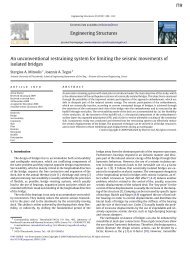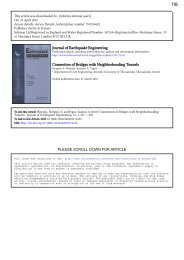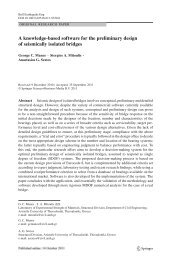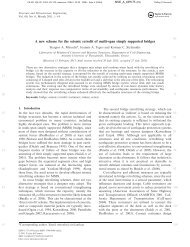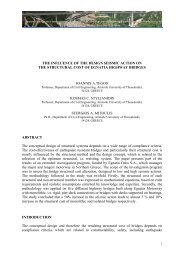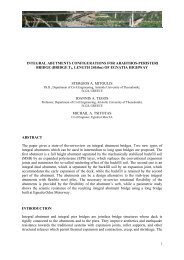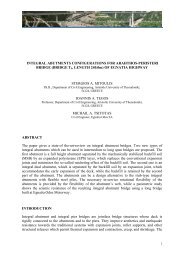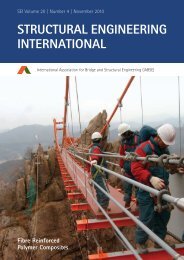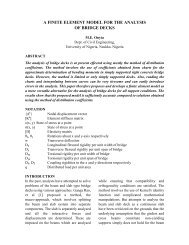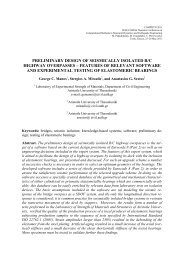18 Preliminary design of seismically isolated RC highway overpasses
You also want an ePaper? Increase the reach of your titles
YUMPU automatically turns print PDFs into web optimized ePapers that Google loves.
Axial Stress (Mpa)<br />
Axial Stress (Mpa)<br />
George C. Manos, Stergios A. Mitoulis and Anastasios G. Sextos<br />
4 EXPERIMENTAL TESTING<br />
An experimental investigation was carried out aiming at establishing the mechanical characteristics<br />
<strong>of</strong> elastomeric bearings locally produced. For this purpose a series <strong>of</strong> standard tests<br />
were performed at the Laboratory <strong>of</strong> Strength <strong>of</strong> Materials and Structures <strong>of</strong> Aristotle University<br />
according to the International Standard ISO 22762-1 (2005). Initially, these tests were<br />
used as qualification tests for the materials used in the production; that is the neoprene, the<br />
steel plates and the adhesion materials and processes. These tests are presented in a summary<br />
form and discussed in what follows. Next, in an effort to study the influence <strong>of</strong> certain parameters<br />
in the mechanical characteristics <strong>of</strong> these elastomeric bearings, the vulcanization process<br />
was investigated. Finally, compression and shear tests were also conducted with elastomeric<br />
bearings as will be presented in the following subsections.<br />
Tensile Test 5- 6 - 7 1.0Hz - 2.0Hz - 4.0Hz<br />
4.0Hz<br />
3<br />
2.0Hz<br />
1.0Hz<br />
2<br />
E=0.75Mpa<br />
1<br />
0<br />
-1 -0.5 0 0.5 1 1.5<br />
-1<br />
Axial Strain<br />
Figure 1a. Tensile cyclic tests with 200% strains<br />
Tensile Test11 Static - 0.50Hz 35 Cycles<br />
actuator<br />
10<br />
8<br />
6<br />
4<br />
2<br />
0<br />
-2 -1 0 1 2 3<br />
Axial Strain<br />
Figure 1b. Tensile cyclic tests with 400% strains that<br />
lead to the fracture <strong>of</strong> the specimen<br />
4.1 Tensile cyclic tests <strong>of</strong> the neoprene<br />
Eleven tests were performed with frequencies varying from 0.25Hz to 4.0Hz. At the end <strong>of</strong><br />
the series the specimens failed at maximum axial strain 400% and maximum axial stress<br />
8MPa. At fracture the specimen underwent approximately 500 cycles. The approximate<br />
Young’s modulus was found to be equal to 0.75MPa. At high levels <strong>of</strong> axial strain (more than<br />
100%) this value was more than double. At even higher levels <strong>of</strong> strain this value was further<br />
increased. At the initial static load-unload cycles there was a considerable difference in the<br />
load-unload path that tended to become less pronounced when the loading cycles increased in<br />
numbers. There was no noticeable influence on the behavior <strong>of</strong> the specimen arising from the<br />
frequency <strong>of</strong> the loading. The cyclic loading was introduced from an initial condition that was<br />
the result <strong>of</strong> preloading it with 50% <strong>of</strong> the target maximum strain level. Figure 1a depicts the<br />
test results for maximum target strain 200% whereas figure 1b depicts similar results for maximum<br />
target strain 400% which resulted in the fracture <strong>of</strong> the test specimen.<br />
4.2 Shear cyclic tests <strong>of</strong> unit slices <strong>of</strong> elastomeric bearings<br />
Shear cyclic tests <strong>of</strong> a specimens made <strong>of</strong> two unit slices were performed according to the<br />
International Standard ISO 22762-1 (2005). For the prismatic specimens each unit slice included<br />
a layer <strong>of</strong> elastomer and two steel plates from a bearing with plan dimensions 200mm<br />
x 200mm. The dimensions <strong>of</strong> each slice <strong>of</strong> elastomer were 200mm x 200mm and 7.62mm<br />
thickness for the orthogonal specimens (figure 2a); for the cylindrical specimens the diameter<br />
<strong>of</strong> the elastomer was 250mm and its thickness 7.62mm (figure 2b) with the appropriate steel<br />
plating. Thus, the tested specimens were formed by two slices <strong>of</strong> elastomer and four steel<br />
plates. Each steel plate had a thickness <strong>of</strong> 2.94mm and sufficient dimensions in plan to have<br />
6






